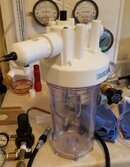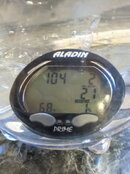@Akimbo, what hand water pump would you suggest? Would it be "safer" to fill most of the container with water and then use an air bicycle pump to pressurise the system?The safe solution is to fill the filter housing with water and pressurize it with a small hand-operated water pump, NOT with air pressure.
You are using an out of date browser. It may not display this or other websites correctly.
You should upgrade or use an alternative browser.
You should upgrade or use an alternative browser.
Building a Transparent Pressurize cylinder
- Thread starter Shahid4u
- Start date
Please register or login
Welcome to ScubaBoard, the world's largest scuba diving community. Registration is not required to read the forums, but we encourage you to join. Joining has its benefits and enables you to participate in the discussions.
Benefits of registering include
- Ability to post and comment on topics and discussions.
- A Free photo gallery to share your dive photos with the world.
- You can make this box go away
Would it be "safer" to fill most of the container with water and then use an air bicycle pump to pressurise the system?
NO! The whole idea is to eliminate compressed air in the system. Expanding air on failure is the dangerous part.
what hand water pump would you suggest?
I would check with an industrial hydraulics supplier and explain that all you need is less than 14 Bar/200 PSI. A old warn out hydraulic hand pump will easily do that. You would have to use a degreaser to clean out the hydraulic fluid before filling it with water.
I'll go out on a limb here and disagree with @Akimbo . Just a little.The whole idea is to eliminate compressed air in the system. Expanding air on failure is the dangerous part.
My transparent pressure pot for testing computers is made from a standard water filter from Lowe's. It's rated to 150 psi, which is more than I need.


For ease of use, and adequate safety, I fill it 95% with water, but leave a pint of air at the top. I've attached a Schrader valve, and use a hand bicycle pump to pressurize the system. The air buffer gives me control as I "dive" the computer. A liquid-only system would be much more difficult to build and operate.
In the event of catastrophic (explosive) failure, I'm only looking at less than one pint of air expanding to 3-4x its volume. That poses no danger to me unless my nose happens to be pressed up against the pot at the moment of failure.
Safe enough. Cheap. Easy.
But @Akimbo is right. Careful with the air!
Polycarbonate (Lexan) vs Acrylic (Lucite) - Colorado PlasticsHi,
I am looking for building a Transparent Pressurize cylinder to withstand a pressure of 300 psi. I am bit confused of Using either Poly carbonate or Acrylic as the material. Can anyone help me on this.
These guys provide a good description of the differences in the two materials. I think polycarbonate will be the better choice for this application.
In the event of catastrophic (explosive) failure, I'm only looking at less than one pint of air expanding to 3-4x its volume. That poses no danger to me unless my nose happens to be pressed up against the pot at the moment of failure.
The risk in this case is essentially zero IF the failure occurs in the water filled area. A failure in an air filled space is the danger because most plastics will break off small shards that become projectiles. Here is the risk in your system:
The injection molded fittings (top of the filter housing and PVC fittings) will have enough air in them to send out Shrapnel on failure. Think about it, it is effectively no different than pressurizing a piece of PVC pipe with air since the water-filled "plug" is functioning the same as a cap on the pipe. Also consider that you have compromised the PVC cap by drilling and tapping it.
The solution is very simple. Remove all the PVC fittings from the filter housing.
- Install a metal street elbow in both ports of the filter housing.
- Add a metal nipple and bell reducer (female x female that is 1/4" on the small end) to one elbow. The nipple should have enough volume (be long enough) to hold all the air in the system. That provides your air reservoir of a know small volume AND eliminates air from wetted plastic surfaces.
- Screw a 1/4" nipple to the bell reducer and a 1/4" tee with one end point up
- Screw the Schrader Valve into the side/horizontal port of the tee
- The top port of the tee will be plugged after filling with water (see below)
- Add a male x 1/4" female reducer to the other street elbow
- Install a inexpensive drain cock valve in the reducer for venting air.
Now your system would be safe to slowly pressurize through the Schrader Valve with a hand pump. A failure in the plastic parts will drop pressure so fast that wetted surfaces will not produce airborne plastic bits. Failure in metal parts just split without breaking off bits.
You could get more sophisticated by adding a water fill valve and needle valve to vent the system in order to run decompression profiles on the computer.
Historic Trivia:
The Schrader Valve was invented by August Schrader who was also one of the largest producers of heavy gear diving helmets in the US.
If the air in contact really matters why not just turn it upside down?The risk in this case is essentially zero IF the failure occurs in the water filled area. A failure in an air filled space is the danger because most plastics will break off small shards that become projectiles. Here is the risk in your system:
The injection molded fittings (top of the filter housing and PVC fittings) will have enough air in them to send out Shrapnel on failure. Think about it, it is effectively no different than pressurizing a piece of PVC pipe with air since the water-filled "plug" is functioning the same as a cap on the pipe. Also consider that you have compromised the PVC cap by drilling and tapping it.
The solution is very simple. Remove all the PVC fittings from the filter housing.
Open the drain cock valve and add water through the top port of the tee to "top-off" the system. The objective is to eliminate air from contact with plastic parts of the filter housing. Stop adding water when it comes out the drain cock and close it. Screw in a 1/4" plug in the top port of the tee to close the system.
- Install a metal street elbow in both ports of the filter housing.
- Add a metal nipple and bell reducer (female x female that is 1/4" on the small end) to one elbow. The nipple should have enough volume (be long enough) to hold all the air in the system. That provides your air reservoir of a know small volume AND eliminates air from wetted plastic surfaces.
- Screw a 1/4" nipple to the bell reducer and a 1/4" tee with one end point up
- Screw the Schrader Valve into the side/horizontal port of the tee
- The top port of the tee will be plugged after filling with water (see below)
- Add a male x 1/4" female reducer to the other street elbow
- Install a inexpensive drain cock valve in the reducer for venting air.
Now your system would be safe to slowly pressurize through the Schrader Valve with a hand pump. A failure in the plastic parts will drop pressure so fast that wetted surfaces will not produce airborne plastic bits. Failure in metal parts just split without breaking off bits.
You could get more sophisticated by adding a water fill valve and needle valve to vent the system in order to run decompression profiles on the computer.
Historic Trivia:
The Schrader Valve was invented by August Schrader who was also one of the largest producers of heavy gear diving helmets in the US.
If the air in contact really matters why not just turn it upside down?
Because that will trap air in the filter housing... if I understand you correctly.
If you are correct it takes the risk out of the red square area of your photo. I just don't believe there is that much risk with just enough air to bring the pressure up. Obviously some stored energy but the amount is fairly low. I installed a pvc pipe air system in my first shop. Had no money for anything else. I know many farmers that use pvc for air. My system is still working over 30 years later and so far it still works. I know a bunch of farmers that have done the same. I recognize the danger but don't believe it is as serious as you make it to be,Because that will trap air in the filter housing... if I understand you correctly.
The risk in this case is essentially zero IF the failure occurs in the water filled area. A failure in an air filled space is the danger because most plastics will break off small shards that become projectiles. Here is the risk in your system:
The injection molded fittings (top of the filter housing and PVC fittings) will have enough air in them to send out Shrapnel on failure. Think about it, it is effectively no different than pressurizing a piece of PVC pipe with air since the water-filled "plug" is functioning the same as a cap on the pipe. Also consider that you have compromised the PVC cap by drilling and tapping it.
The solution is very simple. Remove all the PVC fittings from the filter housing.
Open the drain cock valve and add water through the top port of the tee to "top-off" the system. The objective is to eliminate air from contact with plastic parts of the filter housing. Stop adding water when it comes out the drain cock and close it. Screw in a 1/4" plug in the top port of the tee to close the system.
- Install a metal street elbow in both ports of the filter housing.
- Add a metal nipple and bell reducer (female x female that is 1/4" on the small end) to one elbow. The nipple should have enough volume (be long enough) to hold all the air in the system. That provides your air reservoir of a know small volume AND eliminates air from wetted plastic surfaces.
- Screw a 1/4" nipple to the bell reducer and a 1/4" tee with one end point up
- Screw the Schrader Valve into the side/horizontal port of the tee
- The top port of the tee will be plugged after filling with water (see below)
- Add a male x 1/4" female reducer to the other street elbow
- Install a inexpensive drain cock valve in the reducer for venting air.
Now your system would be safe to slowly pressurize through the Schrader Valve with a hand pump. A failure in the plastic parts will drop pressure so fast that wetted surfaces will not produce airborne plastic bits. Failure in metal parts just split without breaking off bits.
You could get more sophisticated by adding a water fill valve and needle valve to vent the system in order to run decompression profiles on the computer.
Historic Trivia:
The Schrader Valve was invented by August Schrader who was also one of the largest producers of heavy gear diving helmets in the US.
Similar threads
- Replies
- 60
- Views
- 2,649
- Replies
- 3
- Views
- 314
- Replies
- 15
- Views
- 1,091
- Replies
- 13
- Views
- 649



